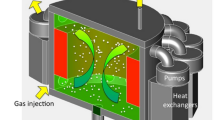Abstract
The MCBurn, a coupled code system linking the Monte Carlo N-particle transport code (MCNP) and Oak Ridge isotope generation and depletion code (ORIGEN), can resolve the basic calculation problems in reactor physical design and analysis, such as criticality, power distribution, nuclide burn up, and neutron fluence. It has been verified in the pressurized water reactor (PWR) pin model, fast reactor (FR) burn up model, and boiling water reactor (BWR) assemble model with benchmarked results. In supercritical water reactor (SCWR) physical calculations, the calculation conditions such as the geometry, the neutron spectrum, and the fuel materials, etc., are more complex than those in traditional reactors, which is a great challenge to reactor physics calculation code. However, the MCBurn code is a possible solution. In this paper, several update functions of the MCBurn in new neutron cross-section lib, code interface, and neutron flux distribution were described. The application of the MCBurn in SCWR were verified on a supercritical water reactor assemble. The calculation results show that the MCBurn is accurate and adaptable in the SCWR calculation.
Similar content being viewed by others
References
Briesmeister J F. MCNP-A General Monte Carlo N-Particle Transport Code. Technical Report LA-12625-M, Version 4B. Los Alamos National Laboratory, 1997
Croff A G. A User’s Manual for ORIGEN2 Computer Code. Report ORNL/TM-7175. Oak Ridge National Laboratory, 1980
Trellue H R. Development of Monteburns: A Code That Links MCNP and ORIGEN2 in an Automated Fashion for Burnup Calculations. Technical Report LA-13514-T. Los Alamos National Laboratory, 1998
Moore R L, Schnitzler B G, Wemple C A, et al. MOCUP: MCNPORIGEN2 Coupled Utility Program. Report INEL-95/0523. Idaho National Engineering Laboratory, 1995
Wang Kan, Lou T P, Greenspan E, et al. Benchmarking and validation of MOCUP. Proceedings of the 2000 ANS International Topical Meeting on Advances in Reactor Physics and Mathematics and Computation into the next Millennium, Pittsburgh, PA, 2000, 15202
DeHart M D, Brady M C, Parks C V. OECD/NEA burnup credit calculational criticality benchmark phase I-B results. Repot NEA/NSC/DOC (96)-06(ORNL-6901). Oak Ridge National Laboratory, Oak Ridge TN, 1996
Nuclear Energy Agency/Working Party on Physics of Plutonium Recycling, Organisation for Economic Co-operation and Development. Fast Plutonium-Burner Reactors: Beginning of Life (A report by the Working Party on the Physics of Plutonium Recycling of the NEA Nuclear Science Committee: Physics of Plutonium Recycling, Volume 4). Paris: OECD, 1995
Hofmeister J, Waata C, Starflinger J. Fuel assembly design study for a reactor with supercritical water. Nuclear Engineering and Design, Fig. 5 Fuel burnup in different areas 2007, 237(14): 1513–1521
Author information
Authors and Affiliations
Corresponding author
Rights and permissions
About this article
Cite this article
Yu, G., Wang, K. Development of MCBurn and its application in the analysis of SCWR physical characteristics. Front. Energy Power Eng. China 3, 348–352 (2009). https://doi.org/10.1007/s11708-009-0031-z
Received:
Accepted:
Published:
Issue Date:
DOI: https://doi.org/10.1007/s11708-009-0031-z




